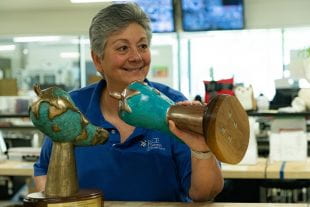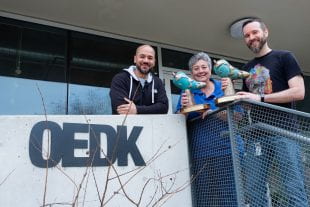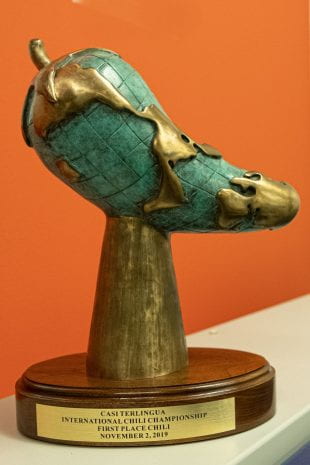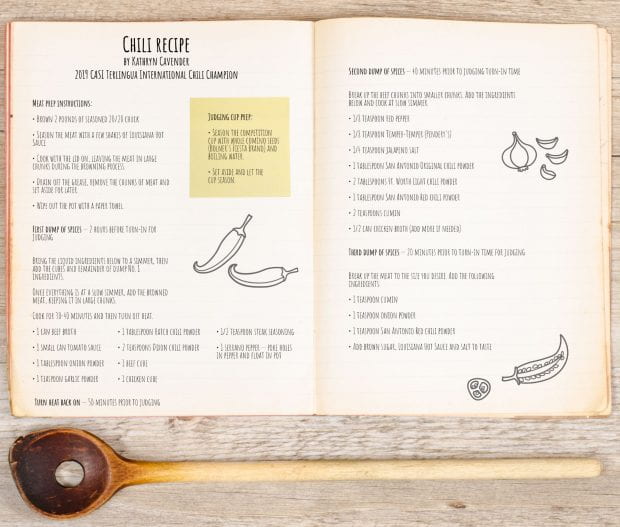OEDK designs lightweight replica for Rice’s own Terlingua chili champ, Kathryn Cavender
When Kathryn Cavender won the 53rd annual Terlingua International Chili Championship last November, she took home two things in addition to eternal bragging rights: a triumphantly red jacket trimmed in gold — if Terlingua is the Masters of chili competitions, this is its green jacket — and a 26-pound bronze trophy of a globe in the shape of a giant jalapeño.

Rice’s own Kathryn Cavender won the CASI Terlingua International Chili Champion — and a 26-pound bronze trophy of a jalapeño. The OEDK made a 3D-printed version that’s only 3 pounds. (Photos by Jeff Fitlow)
The jacket is easy to transport; Cavender, Rice’s longtime director of environmental health and safety, simply wears it to the dozens of competitions she’s participating in this year as the reigning Terlingua champion.
The trophy, on the other hand, had to be packed into a bulky plastic clamshell that added even more mass to the already-hefty jalapeño. Lugging it to competitions in Texas was one thing — Cavender just made the drive northeast to Lindale for a recent cook-off — but out-of-state competitions would mean flying with the trophy. Cavender didn’t want to struggle with hefting the case into overhead bins, nor did she want to check the priceless trophy.
“So the very first thing I did was I called the OEDK and I said, ‘Can you make me a 3D print of it?’” Cavender said.
A 3D scanner and printer are just two of the pieces of tech to be found inside Rice’s two-story Oshman Engineering Design Kitchen, or OEDK, which contains everything one might need for design projects, from laser cutters and soldering stations to a wet lab and a wood shop.
But creating a portable plastic model of the trophy would be easier said than done.
Not only was the jalapeño shape a challenge for the 3D scanner to capture due to its many overhangs and curves, the bronze surface was shiny and reflective in areas, making it difficult for the scanner’s lasers to capture those parts. Engineering design supervisor Danny Blacker and engineering design technician Fernando Cruz kept at it, determined to solve the problem.
“It just didn’t work at all,” Blacker said.

Engineering design technician Fernando Cruz (at left) and engineering design supervisor Danny Blacker (at right) worked with Cavender to replicate a lightweight trophy she could travel with to chili competitions across the U.S.
Eventually, they realized they’d have to create dozens of smaller scans of the trophy and then line them up manually, stitching them together in the computer like skilled surgeons.
“It was a digital puzzle,” Cruz said.
The scans — 30 in total — took hours to complete. And then there was the new puzzle of how to print the finished piece, which would take six days. Once again, the multiple overhangs made it difficult for the 3D printer to render the underside of the trophy.
“It looked like melted plastic,” Cruz said.
Then, an idea: They had stitched together the trophy digitally. They could do the same with the plastic version.
“So I decided to cut it in half,” Blacker said. “And we printed it in two different halves.”
Blacker carefully joined the two pieces and Cruz smoothed the plastic to a fine buff that hid the bifurcation, then primed and painted it to look just like the original.
The second version of the trophy was a success. At only three pounds, it was one-eighth of the original trophy’s weight, mounted on a wooden base Cavender had carved. The rendering process had even captured such fine details as the “CASI” engraving on one side — the Chili Appreciation Society International has hosted the Terlingua cook-off since 1967 — and the artist’s signature on the bottom.
The entire process took a little over two months.

The original trophy has reflective surfaces and multiple overhangs, which made scanning difficult.
“I never had any idea what it was going to entail,” Cavender said, marveling at the end result one recent morning at the OEDK.
Blacker laughed. “Yeah, it seemed easier in our head,” he said.
Throughout the process, however, Rice students were able to watch and learn from the design technicians as they brainstormed in the big, open lab space. The engineers learned a few things too, which they’ve already been able to put to use.
“We rarely used the 3D scanner until this point, and we’ve learned so much just by making this chili pepper,” Cruz said.
One student, in fact, was working on a design project that involved needing to create a clip that fit atop a sonogram instrument. It had to fit perfectly. So Blacker applied the same techniques to creating a 3D model of the clip as he had the chili pepper.
“Had we not done (the trophy), we wouldn’t have been well-versed enough in the 3D scanner to help him, so it really worked out,” Blacker said.
Now, when she’s able to, Cavender travels with both trophies: the portable, lightweight version and the real one that’s eight times heavier. She enjoys sharing what Rice’s unconventional wisdom can produce almost as much as she enjoys sharing her prize-winning chili.
Want the recipe? Cavender is happy to share that too.


